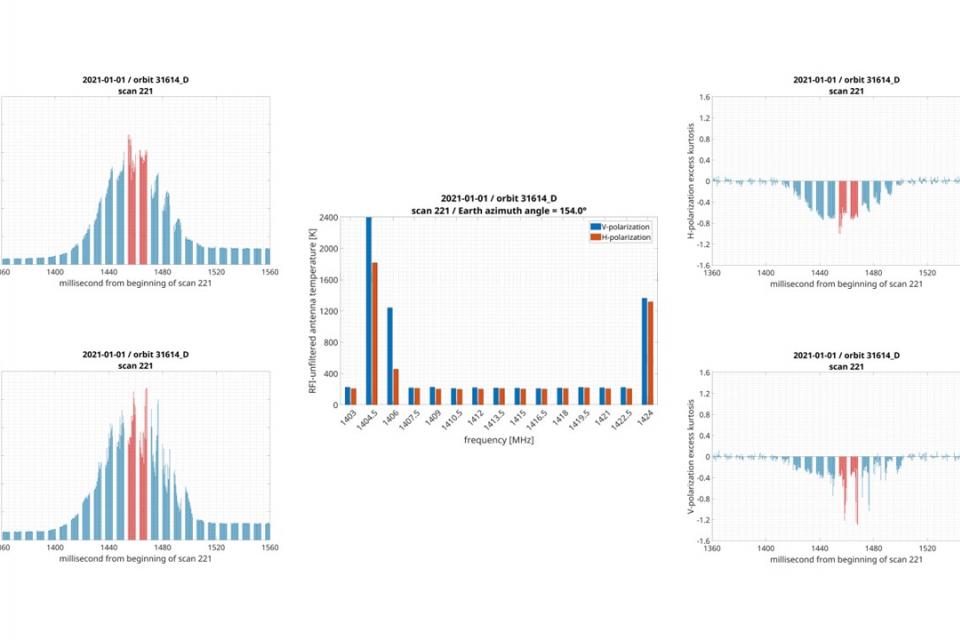Datasets
Standard Dataset
SMAP RFI Kurtosis
- Citation Author(s):
- Submitted by:
- David Le Vine
- Last updated:
- Thu, 06/22/2023 - 11:41
- DOI:
- 10.21227/dr7d-9n96
- Data Format:
- License:
 156 Views
156 Views- Categories:
- Keywords:
Abstract
Radio frequency interference (RFI) is a problem in microwave remote sensing even for sensors operating in the protected band at 1.4 GHz (L-band). Unfortunately, little is known about the sources of the interference, which complicates the design of systems to deal with it. The SMAP radiometer is unique in that it comprises an array of tools to detect RFI, including spectral information and kurtosis in addition to the more conventional time-domain thresholding. This data set contains examples used in an investigation to determine if the kurtosis (K) can be combined with the information about the spectrum of the RFI to identify characteristics of the source of the RFI. The attached figure is an example of one the case studies.
The data presented here are examples of RFI detected by SMAP. Each example contains five JPEG figures: Time dependence of the fullband antenna temperature, Ta, for both vertical and horizontal polarization for 200 ms during the interference; The time history of the associated kurtosis for each polarization; and a figure showing the spectral information for the footprint of closest approach during the RFI. The information included in the JPEG file name for each figure is (in order): Name, Latitude, Longitude, Date, SMAP orbit; Scan number; Time (ms from scan start)
Dataset Files
- Albania 41.3 19.8 2021-01-01 32614_D 221 1360 1560 Albania 221.jpg (112.10 kB)
- Albania 41.3 19.8 2021-01-01 32614_D 248 2500 2700 Albania 248.jpg (110.70 kB)
- Algeria 34.6 -0.7 2021-04-01 32938_A 511 900 1100 Algeria 551.jpg (113.37 kB)
- Algeria 34.6 -0.7 2021-04-01 32938_A 546 2960 3160 Algeria 546.jpg (120.44 kB)
- Bangladesh 23.0 91.5 2021-04-04 32971_D 305 2420 2620 Bangladesh 305.jpg (119.52 kB)
- Canada 63.3 64.2 2021-04-02 32955_A 630 380 580 Canada Brevoor Island.jpg (111.73 kB)
- Canada 68.8 81.2 2021-04-02 32955_A 689 2800 3000 Canada Hall Beach.jpg (113.87 kB)
- China 19.2 109.3 2021-04-03 32970_D 298 600 800 China 298.jpg (116.51 kB)
- India 29.6 80.3 2021-04-02 32942_D 257 500 700 India 257.jpg (117.84 kB)
- Lithuania 55.3 21.8 2021-04-03 32966_A 631 2900 3100 Lithuania 631.jpg (117.84 kB)
- Poland 52.3 17.5 2021-04-03 32966_A 596 1540 1740 Poland 596.jpg (122.20 kB)
- Saudi Arabia (1) 17.1 43.0 2021-04-01 32929_D 333 2580 2780 Saudi Arabia 333.jpg (116.43 kB)
- Spain 36.6 -6.4 2021-04-04 32975_D 258 2800 3000 Spain 258.jpg (114.93 kB)
- Sudan (1) 15.6 32.6 2021-04-02 32944_D 308 1180 1380 Sudan 308.jpg (110.45 kB)
- Sudan (2) 9.6 31.7 2021-04-03 32966_A 438 2160 2360 Sudan 438.jpg (112.83 kB)
- Sudan (1) 15.6 32.6 2021-04-03 32966_A 470 2640 2840 Sudan 470.jpg (109.81 kB)
- Syria 35.3 36.7 2021-04-02 32951_A 517 1180 1380 Syria 517.jpg (118.61 kB)
- US/Mexico 31.7 -106.3 2021-04-04 32986_A 527 2200 2400 USA Mexico 527.jpg (113.75 kB)
- Wisconsin 44.2 -88.6 2022-02-05 37475_A 559 1480 1680 Wisconsin 559.jpg (115.94 kB)
- Croatia 45.9 15.9 2021-04-05 32989_D 186 1400 1600 Croatia 186.jpg (113.13 kB)
- Spain 36.6 -6.4 2021-04-04 32975_D 224 1100 1300 Spain 224.jpg (119.50 kB)
- China 41.24 80.26 2022-01-24 37286_D 216 1240 1440 China 216 (Aksu).jpg (128.65 kB)






